Each of us has a unique personality that makes us who we are.
Personality has to do with a person's overall characteristics and qualities based on how they think, feel and behave.
According to APA's Dictionary of Psychology, it's
"the enduring configuration of characteristics and behavior that comprises an individual's unique adjustment to life, including major traits, interests, drives, values, self-concept, abilities, and emotional patterns"
It is used to understand people using the same dimensions. We share commonalities but, at the same time, we are also very different from one another.
These differences and their reasons are a vital part of the study of personality. They are what makes us unique.
Some of the factors that influence our personality and origins these differences are:
However, we have a shared human nature, and some personality traits can be found in more or less intensity in all of us.
That's where the Big Five comes in.
The Big Five or Five-Factor Model is a valid and widespread measure of personality in use today.
Two critical researchers who dedicated themselves to this theory are Lewis Goldberg, who narrowed down Cattel's 16 "fundamental factors" into five dimensions, and Paul Costa and Robert McCrae, who did extensive work validating these dimensions.
The theory captures most of each individual's common traits and characteristics. They can be narrowed down into five dimensions of personality: openness, conscientiousness, extraversion, agreeableness, and neuroticism.
Together, they form the acronym OCEAN.
We can view these broad dimensions of personality as a spectrum on which several related traits and characteristics fall under.
So, when using the Big Five theory, saying someone either is or isn't conscientious, for example, is misguided.
These traits aren't dichotomous. Instead, the right notion would be that someone is low in conscientiousness.
Everyone has all of these traits. The question is, at what level? And how do they relate to each other?
Generally, the Big Five stays consistent throughout one's life, but they can vary as one grows into adulthood.
Currently, this model is the most widely accepted way of viewing personality, so it's essential to understand what each trait stands for.
Openness to experience (O) is the tendency to try and learn new things. It is associated with imagination and intellect.
The traits associated with this dimension include being curious, imaginative, insightful, daring, original, and clever.
People high in O are often creative, open to change, and appreciative of learning new things.
People low in O often prefer a routine, are closed to new ideas and do not like change.
Openness can manifest as fantasies, aesthetics, feelings, actions, ideas, and values.
Openness may help develop intelligence; in turn, intelligence may predispose the individual to openness. However, the two are separate dimensions of individual differences.
Conscientiousness (C) stands for the ability to control impulses and have self-discipline.
Traits associated with conscientiousness are discipline, hard work, and thoroughness.
People high in C tend to be consistent, organized, reliable, and dependable in their work.
People low in C are more impulsive, spontaneous, disorganized, careless, find it more difficult to finish tasks, and tend to procrastinate.
Conscientiousness has a lot to do with direction. Someone high in C is purposeful and adheres to plans with an objective in mind. This means that someone low in conscientiousness is not so much uncontrolled as undirected.
Extraversion (E) has to do with how someone seeks and draws energy from their social environment. It's what we commonly know as extroversion, in contrast to introversion.
Traits that fall under this are outgoing, energetic, and friendly.
People high in E are often talkative, affectionate, and are comfortable meeting and interacting with new people.
People low in E (introverts) tend to be more shy, reserved, contemplative, and quiet.
What extraversion comes down to is the enjoyment of others' company.
Generally, extroverts get energized by socializing with other people. In contrast, introverts feel depleted after spending time with others and need to recharge their energy alone.
Agreeableness (A) is the tendency to get along with other people.
Traits associated with it are kind, polite, helpful, humble, patient, and sensitive.
People high in A are generally considerate of other people's feelings and needs, are well-liked by others, and have great tact.
People low in A are more antagonistic, mistrustful, skeptical, rude, and inconsiderate.
While some highly antagonistic people may be aggressive, others are polished manipulators.
Neuroticism (N) is one's tendency to worry and is related to emotional instability and confidence.
This trait is perhaps the most agreed on between personality researchers, and it originated from psychologists' concerns with psychopathology.
People high in N tend to be pessimistic, fearful, anxious, insecure, moody, and angry.
People low in N are more emotionally stable, calm, confident, and self-assured.
Neuroticism can also be linked with poor coping skills, like hostile reactions and wishful thinking.
As we've mentioned, each trait can be interpreted as a spectrum on which we all fall.
Naturally, higher levels of some traits are more desirable than others.
For example, most people wish to be high in agreeableness and openness, while we'd struggle to find someone who'd want to be high in neuroticism.
However, there's a balance to be achieved. Having too much of anything, even if it's supposedly a good thing, can end up being maladaptive.
Take conscientiousness, for example. On the one hand, organization and self-discipline are traits that can take us far and help us achieve our goals and fight for what we want.
On the other hand, being too high in conscientiousness may make us too inflexible and leave no room for spontaneity in our lives.
Even being extremely high in agreeableness can trouble us. People with high scores in A can be dependent and have difficulty imposing themselves even when necessary.
It is well established that genes play a major role in one's personality. It's believed that 40-60% of individual differences in personality can be attributed to genetic variations.
Nonetheless, there's still an extensive amount of who we are that's determined by our environment and upbringing, whether we're conscious of it or not.
Babies aren't born with a set and unchangeable personality; instead, we're all born with a temperament that makes us predisposed to certain traits.
How these traits develop and change over time will heavily rely on how we're raised and the interactions we have in our lives.
For example, it's believed that parental warmth is linked to high child extraversion, agreeableness, conscientiousness, openness to experience, and low child neuroticism.
In its turn, parental behavior control is linked to positive child conscientiousness.
However, the temperament we're born with also influences how we react to our environment.
In a 2016 study, it was found that children with high negative emotionality, which can be compared to neuroticism, are especially sensitive to both good and bad parenting.
This means that these children suffer more in a hostile environment but greatly thrive when they receive good care. The researchers noted that
"the very individuals most vulnerable to environmental stressors may be the ones who benefit most from environmental support."
While parenting does play an essential role in our personality, a longitudinal 2021 study³ analyzing the association between parenting and child Big Five personality traits found only a small association between the two.
This points to the notion that it's not a few large environmental factors that will set our personality in stone. Instead, our personality is influenced by many environmental factors, each playing a small yet essential role in our development.
Moving on from our early years, our Big Five personality traits can also change based on significant life events later in life.
Romantic relationships, life transitions, jobs, losses - these are all factors that can change us.
For example, when we enter our first job, it's demanded that we practice traits such as organization, reliability, and engagement.
These are all characteristics that relate to conscientiousness and could change our thoughts, feelings, and behaviors, translating to other areas of our lives and having a lasting impact on us.
Differences in personality traits among genders are not apparent in the Big Five but are more evident in the aspect level.
When we say aspect level of traits, we mean more specific characteristics that make up the Big Five.
For example, women score higher in neuroticism than men do. Upon examining the aspect level of neuroticism, women were found to have higher scores of Withdrawal, which is associated with depression and anxiety. On the other hand, men have higher scores of Volatility, which is associated with irritability and temperament. This gap in neuroticism usually tends to decrease as they grow older.
In terms of agreeableness, women tend to have higher scores than men. As they grow older, the difference tends to widen. On further examination of the aspect level, women were high in Compassion and Politeness.
Women also tend to receive slightly higher scores of extraversion than men. The aspect level consists of Enthusiasm and Assertiveness. Women get higher scores in Enthusiasm; they are more sociable and more likely to experience positive emotions. Meanwhile, men have scored highly in Assertiveness, which is characterized by agency and dominance.
While no significant differences exist in conscientiousness between genders, the aspect trait within this dimension shows detailed information on gender differences. That is, women have higher scores of Orderliness than men. As a result, they will be more likely to follow a schedule and ensure things are done perfectly.
The same observation was made in openness to experience. No gender difference was immediately apparent, but upon examining the aspect traits within this dimension (Openness and Intellect), it was found that women were higher in openness while men rated higher in Intellect. This doesn't mean that men are more intelligent than women. It might only mean that men are more confident in their abilities. As people grow older, there aren't any differences in Intelligence, which may mean that women become aware and confident of their capabilities.
The personality differences observed between men and women are associated with a normative pressure to conform with gender-based social expectations, which are plenty.
Western societies stimulate women to favor positive social traits, reflecting on their Extraversion and, especially, Agreeableness scores. As for men, they're expected to be more dominant and refrain from expressing sadness, but not from expressing anger. This is illustrated by their Volatility and Assertiveness scores.
Also, women are generally more aware of how others perceive them than men. This self-consciousness derives from normative pressures for women to look and act a certain way and contribute to higher scores in neuroticism.
The Big Five personality traits play an important role in predicting how someone will act in the workplace.
The trait most associated with workplace behavior is conscientiousness, which doesn't come as a surprise since it's related to self-discipline and organizational skills.
People high in conscientiousness display extensive job-related knowledge and focus on their performance at work. They're also likely to become strong leaders.
The con of being too conscientious in the workplace is not leaving much space for creativity and flexibility, which is a skill most jobs require often.
Conscientiousness, along with extraversion and agreeableness, is also positively linked to job satisfaction.
In the workplace, people high in agreeableness tend to be well-liked and easily follow the rules.
As for extroverted people, it's believed they are strong leaders but are more impulsive than their introverted peers.
People high in openness also make for good leaders as they greatly adapt to changes, making them steadily productive over a long time.
Lastly, people high in neuroticism are likelier to be dissatisfied with their job and have a tendency to experience employee burnout.
There's several different individuals you'll encounter in a workplace, each one with their way of working. Therefore, what makes for a great coworker and leader is understanding how all personalities differ and the distinctive traits they encompass.
The Big 5 personality traits that have the most impact on relationships are extraversion, agreeableness, and neuroticism.
To start, people high in extraversion will usually have a wider network of friends. They are often very cheerful and experience and express positive emotions more readily. You can expect them to have good social skills.
During first encounters, they don't like new people more than introverts do. However, they do tend to be more liked by the people they meet in the first instance. They are more inclined to socialize and mingle with other people, leaving a lasting first impression.
People in high in extraversion often take care of their friendship better especially when conflicts come their way. Moreover, they seem to be good at actively and constructively addressing problems.
Moving on to agreeableness, people high in this trait develop and maintain their friendships really well.
You'll usually find agreeable people having deep solid friendships. They are very helpful and cooperative with the people around them. They also won't explode on you when they become angry.
Compared to extroverts, they are less likely to seek new friends but get chosen as friends more by others.
Being more agreeable can help keep relationships healthy. They're more forgiving than those low in agreeableness, who are more likely to experience poorer romantic relationships and more divorces.
The third major personality trait that affects relationships is neuroticism, but it does so negatively.
You can expect people with high scores of neuroticism to be more emotionally reactive and likely to experience and display negative emotions. They'll have fewer friends than other people do.
More often than not, they can assume beforehand that they won't be liked by the new people they meet. They tend to be cautious and self-conscious during these encounters.
This is also true when studies examined romantic relationships. People high in neuroticism often expect the worst-case scenarios to happen.
Oftentimes, they will seek reassurance from their peers even though they've already been reassured, which can jeopardize their relationships.
In handling conflict, they will usually avoid and neglect the issue at hand.
Interestingly, you will usually find happy couples when their scores on neuroticism match each other.
Conscientiousness and openness to experience do not have as big an impact as the first three, but there are still some interesting correlations.
Conscientiousness plays a small role in maintaining friendships.
People high in conscientiousness perceive better and more satisfying relationships with their friends and partners and experience more positive feelings about it. They often perceive good support from their family members as well.
They also tend to initiate conflict resolution and are less likely than others to split up with their partners.
People who are high in openness tend to have friends that match their score in this trait.
Unsurprisingly, you can usually find them to have many friends.
Moreover, they're able to handle conflicts constructively. One reason for this may be because they can look at the issue from different perspectives, helping them make informed decisions.
The Big Five factors are known to be stable against the influence of relationship experiences. However, when a person's personality characteristics change, it affects the way they perceive their surroundings like the support they receive from family members.
Research conducted by the American Psychological Association found that assessing a patient's personality during routine medical exams might be as useful as recording their family medical history.
This is due to some interesting results the study landed at.
Firstly, being high in conscientiousness appears to be one of the best predictors for good health. The most conscientious people at 26 years old ended up being the ones with the best health at 38, in comparison with those low in this trait.
This is probably due to the fact that conscientious people tend to maintain healthy diets and are less probable to abuse alcohol and drugs.
Individuals low in conscientiousness were more likely to have high cholesterol, inflammation, hypertension, and risk of gum disease.
Similarly, neuroticism helps predict the quality and longevity of our lives. This personality trait is linked to several mental health disorders, such as depression, anxiety, eating disorders, and substance abuse disorders.
Furthermore, people high in neuroticism are likelier to have medically unfounded somatic complaints. However, there are studies that found correlations between this personality trait and serious physical health problems such as cardiovascular disease and disrupted immune functioning.
Still, these physical health problems are heavily associated with anxiety and depression, which could explain the link with neuroticism.
Individuals high in neuroticism and low in Conscientiousness, Agreeableness, and Extraversion also present a higher risk of mortality.
Lastly, individuals who score high in Extraversion tend to engage more frequently in drug use. This happens because extroverted people generally seek out social experiences and rewards.
Even though the Big Five theory is the preferred model today to test personality, it has received some criticism from personality researchers and, like any other test, has its limitations.
There have been published articles and research pointing that there are personality traits that lie beyond the five factors, such as Humorousness, Deceptiveness, Honesty, Conceit, Thriftiness, and others.
According to Paunones and Jackson (2000), the Big Five test can describe meaningful traits and individual differences, but
"there is much important variance in human behavior not accounted for by the Big Five personality traits"
Therefore, any comprehensive description of human behavior should take the Big Five traits into account, but also the ones that aren't represented by it.
The Five Factor Model can provide a rather static notion of personality. McCrea and Costa (1999), the main contributors to the modern Big Five theory, believed that personality develops from childhood until about 30 years old when stabilizes.
However, there's empirical research that personality learning continues throughout our lives, and that we continue to develop past our thirties.
For example, one of these studies found that while among adolescents openness to experience tends to increase, among the elderly it generally decreases.
There is doubt on whether the Big Five applies to different populations across the world. The validity of the test outside of western, uneducated, industrialized, rich, and democratic populations is still unclear.
A study set out to analyze this validity by taking respondents from 23 different low and middle-income countries. The results showed that the questions failed to measure the Big Five personality traits, and different factors appeared to predict different things.
For example, low Neuroticism, and not Conscientiousness, was what best predicted income.
The authors theorized that this inconsistency can be due to differences in cognition and culture, which in turn are linked to differences in other factors.
The Eysenck Personality Questionnaire is a self-report test that measures two broad personality dimensions: Extraversion versus Introversion, and Neuroticism versus Stability. There is also a third scale that measures response distortion due to social desirability, the "Lie Scale".
Both Extraversion and Neuroticism share the same meaning as the Big Five dimensions of the same name.
The 16PF is a self-report test that gave origin to the Big Five theory, and it has been revised over the years.
The results can reveal things such as anxiety, adjustment, emotional stability, and behavioral problems.
Some of the factors that the 16PF measures are: Warmth, Reasoning, Sensitivity, Dominance, Openness to Change, Tension, Vigilance, and others.
This self-report test is based on psychoanalyst Carl Jung's theory on personality. Even though it is often used on hiring processes and such, it has low statistical validity and is not a reliable test.
The questions are set to measure 4 different categories:
In the end, the examinee will end up categorized into one of sixteen different personality types.
The HEXACO Personality Inventory is a self-report tool that measures personality traits quite similar to the Big Five:
The HEXACO model is innovative in its addition of the "Honest-Humility" dimension.
Unlike the Big Five and the last tests mentioned, projective measures are based on Freud's theory on personality and the unconscious.
Most of these tests work by presenting the examinee with ambiguous scenes, blobs, and images or giving broad instructions. The results can reveal unconscious perceptions and patterns of behavior.
Famous projective measures in use today are the Rorschach test, the House-Tree-Person test, and the Thematic Apperception Measure.
For a long time, it was believed that people couldn't change their personalities. The consensus was that you settled into an immutable personality after some time.
Like we've mentioned, even McCrea and Costa, two of the modern Big Five developers, shared that belief.
However, new studies suggest that though it's not easy, we can change our personalities.
As to why people might want to change their personalities, there are a number of different reasons.
First, most of the Big Five traits are socially desirable and reflect emotional maturity. That way, people low in desirable traits might want to change to feel an increase in their intrinsic value.
Second, many people can be dissatisfied with how their lives are going in different areas relative to personality traits. A 2015 study found that people dissatisfied with friendship, relationships, sex life or recreational activities tend to desire an increase in extraversion, while those dissatisfied with their academic and work lives seek an increase in conscientiousness.
This desired change can happen through significant life events, but also through purposeful interventions. As an example of the latter, a 2017 paper found that therapy has the potential of changing personality traits, mainly neuroticism, followed by extraversion.
It makes sense that therapy would lower someone's neuroticism score since it's linked to a number of different psychopathologies.
Besides clinical interventions, people can also conscientiously change by engaging in different patterns of behavior. Normally these patterns of behavior come from different roles we take on throughout our lives.
If we commit to a career, it's likely that we'll become more conscientious and that this change will endure, thus changing our personality.
Increasing conscientiousness in the workplace, for example, means engaging in activities that feel enjoyable, important, and that align with your values. If you wish to be more conscientious, reflect on what of these three factors might be holding you back.
Moreover, creating small and attainable goals that exercise the trait you want to change can help you change your behavior and, in turn, change your personality and how you view yourself.
For example, if you want to become more extroverted, it's possible to create objectives such as "hang out more with friends", or "meet one new person every week".
For whatever reason or means you wish to change, be mindful that you're doing it for the right reasons - not by the demands or actions of others, but by your own values and needs.
There are a number of different websites that allow you to take a free Big Five test. They vary in size and questions, but all of them follow the same premise: There are a number of different phrases and you have to mark, from 1 to 5, how much you agree/disagree. The instructions for the different tests will be available on the websites.
Some of the options are the following:
If you liked to learn about your personality traits and how they affect the different areas of your life, you might want to check out our article on attachment theory!
Attachment theory discusses how we relate to others and our patterns of behavior when it comes to relationships, whether they may be familiar, romantic, or friendship.
Having an understanding of both your Big Five traits and your attachment style can give you the tools to build a more meaningful and fulfilling lifestyle!
Reference list:

To discuss social anxiety, we're going to start talking a little bit about evolution.
In evolution, we, well, evolve things.
For example, we have organs like the appendix that used to be useful to us as humans, but they're not necessary anymore. These are called vestigial organs or limbs.
A lot of times, evolution will leave behind vestigial parts that no longer serve a function.
What's happening right now in society is that going outside used to be a basic need, and now it's not that necessary anymore.
Going outside, to a certain degree, has started to become vestigial.
We have grocery and food delivery; we can hang out on Discord, Twitch, FaceTime, or social media; we can work online, and have a whole community online!
When life is changing, and what we need to survive is changing, there's a lot of judgment that comes along with it.
For example, when articles criticize younger generations for not knowing things that used to be expected, like changing a tire, building things, etc.
The difficulty of going outside can come with a side of shame, making it harder to face this.
The thing is, you actually don't need to go outside, but it's still healthy if you do. You're probably going to suffer if you don't go outside. But start by doing away with the shame and self-blame.
We can also think of this difficulty from a societal point of view. What kind of society exists that allows people to grow without really learning how to "go outside"?
What kinds of circumstances must exist for some to evolve in this state that we're in right now?
What has to happen in our society that going outside becomes vestigial and a thing of the past?
Nobody is fundamentally messed up if they don't know how to go outside. This is a societal occurrence and shouldn't be treated with shame.
It's important to differentiate this from agoraphobia. The latter is a disorder, and what we're discussing is actually generational and societal, but not necessarily pathological.
If you're having trouble going outside, don't over-complicate it with different goals at the same time. For example, don't go out looking to make hobbies and make friends at the same time.
The first thing you should do is literally go outside. Grab a book, a kindle, a phone, and go outside for a walk, library, park, or any other public space that's socially acceptable for you to be alone.
Go to a public space and simply hang out by yourself.

At the start, don't even worry about interaction, just go outside and do simple activities by yourself.
You might feel the urge to avoid these situations, but start by occupying yourself.
You want something to do because if you feel socially awkward, you need to have something at the beginning to alleviate that social awkwardness and do something socially acceptable.
Start by just going outside, sitting at a park bench, taking a walk, doing some reading, and then coming home.
The important thing is that you're leaving the house and doing activities outside, even if you're by yourself.
Some activities might be listening to an audiobook or podcast while on a walk; reading a book on a park bench; going to a museum or exposition; going to a farmer's market.
Do that ideally for 2 to 3 times a week, and when you're ready, bump it up a notch.
Go to a bookstore and ask for help, actually interact with other people, just for the sake of the interaction. You don't need to do it with the objective of making friends.
The next step is joining maybe a club or group activity.
For example, if you go to a bookstore, ask if there's a book club that you could join. Or if you like walking, look for planned group hikes.
For people who are concerned about social interaction, the main thing is focusing on the activity or hobby first, and the social interaction second.
Recognize that people aren't in these places to necessarily make friends, and if you don't make friends, that's not a big deal.
Always focus on the activity at hand, and after a few tries, you're bound to get friendly with people.
Friendship is going to be an organic happening. Once you hang out with people on a regular basis, it will start to happen.
Making friends usually requires a couple of things:
1. Repeated unplanned interactions
You have to, basically, run across the same people over and over again. That's why it's easier to make friends at school, for example.
2. Common cause
You have to have a shared goal that you unite around. For example, in a class, you can have a common goal of passing a test, then you start exchanging notes and studying together.
It is hard overcoming social anxiety, but focusing on these steps can make things easier.
And remember, like any other activity, things will become much more natural with a lot of practice!
Different people have different personalities and cognitive traits, and styles.
In Western psychology, the Five-Factor Model explains that people's personality tends to cluster around 5 different factors:
Conscientiousness is associated with impulse control. This trait is known to govern the impulses and help keep one disciplined and organized. People who are conscientious follows-through with their tasks diligently. They are often more likely to display delayed gratification in working towards their goals.
Here's an example of a person with low conscientiousness:
A student just finished classes for the day. He has a test next week that he can study for or avoid by playing a video game instead. Someone with high conscientiousness will find it easier to study than playing a game.
To put it simply, if we have low conscientiousness, we tend to give in to the thing we want to do. On the other hand, if we have high conscientiousness, we tend to choose something we don't want to do.
Today's society usually rewards people exhibiting high conscientiousness.
What does this mean for people who are low in conscientiousness? Is there anything we can do to boost this?
Can we train ourselves to set aside what we want in favor of what's good for us?
The good news is you can do it! We can improve conscientiousness.
Conscientious people are often described as aware, hard-working, caring, and thoughtful of other people. Given this, to develop conscientiousness, we can just strive to be a nice person.
Consider thinking about helping other people. Know that we will definitely need to put the time and effort into this and this will almost certainly come at a cost to us.
What's important here is restraining our impulses for benefiting ourselves. In doing this, we can train our conscientiousness.
Conscientiousness shouldn't be confused with empathy. Helping people does not necessarily mean empathy right away.
Empathy is the capacity to feel what someone else is feeling. So naturally empathic people will naturally be helpful to other people.
There are a lot of people who are good but are not empathic. They just choose to be good people.
Examples of these are C Suite executives, psychiatrists, surgeons who commonly test highly on the sociopathy scale. Having low empathy allows them to face the high stress that their job entails.
The altruistic sociopath does things to help people but doesn't do it due to empathy. They do not help based on a feeling, but because they choose to set someone else above them due to a cognitive process.
We can practice and develop our conscientiousness through altruism.
If our conscientiousness is low, we need to set aside parts of ourselves in favor of others. As a result, we will train our minds to set aside what we want.
In Eastern religions, there is a term called karma. It is often captured in the statement, "What goes around comes around."
Conscientiousness seems to be the worldly observation that supports this theory of karma. In doing things for other people, based on the theory of karma, we are also training our conscientiousness. We are training our minds to become more restrained and free from our desires.
People who consistently do things for other people find that their lives start to improve too.
Interestingly, the only way for karma to work is through a common element, and that is through us. So we, the individual, are the only common element and the medium of action for karma.
There has to be a change in your brain that connects helping a lady carry her groceries with improving our lives. This missing link is the piece of conscientiousness that we can work to improve on.
To improve conscientiousness, become hard workers, and ultimately improve our lives, we need to recruit an amount of altruism.
The more we set aside what we want and what benefits us to help someone else, the more conscientious we become.
Coaching is also a helpful way that people try to improve conscientiousness. A professional coach can help overcome laziness and implement changes in our lives.
Anxious-Avoidant Attachment happens when, as a child, the person communicates their emotional needs to their caregivers, and they either got no response or neutral response.
For example, a child might have a nightmare and call out for their caregiver during the night. In turn, the caregiver doesn't comfort the child and instead ignores their cries of distress. They might even get irritated by their kid's show of emotions.
These situations can cause a belief that voicing your needs doesn't get a response. So the child ends up becoming very independent, but it's just a mask for their emotional distress, protecting them from getting hurt again.
A person with an anxious-avoidant attachment style keeps partners at arm's length because of their fierce independence and coldness in a relationship. They might always have an exit strategy in a relationship because they avoid commitment and intimacy, leaving their partner feeling unreassured.
It's also rare for them to willfully talk about their feelings with their partners, and they tend to shut their significant others out.
Because of their apprehension of being intimate with significant others, the anxious-avoidant person can produce a lot of insecurities in their partner. In turn, the partner keeps wondering if they are loved back.
These insecurities can lead the partner to accuse the anxious-avoidant person of neglect, selfishness, betrayal, or egocentricity. When this happens, the avoidant person can become more distant and even lash out, blaming the relationship's problems on their partner.
To make a relationship with an anxious-avoidant person work, it's important to remember that their distant attitude comes from fear of letting down their guard and being betrayed or abandoned.
They put up barriers not because they don't care but because being intimate and exposed is very unfamiliar for them.
Getting into blame games will only make the avoidant person retract further, so the best solution is directly addressing each other's fears.
For them, vulnerability is frightening and thought to get them hurt, so their partner can do their best to make closeness feel safe. This includes viewing their tendency to isolate from an empathetic point of view rather than a punitive one.
Lastly, the partner of an anxious-avoidant person should also examine their feelings towards closeness or intimacy. It can happen that they could've picked out someone closed off precisely because they are afraid of closeness.
Because the anxious-avoidant person is always distant and highly independent, it's easier to pass the share of the problem to them than face your own fear of intimacy.
Whatever the case, this kind of relationship requires a lot of empathy and understanding regarding different coping techniques so that both partners can acknowledge and accept the risks of a loving relationship.
References:
Anxious-Ambivalent Attachment style happens when caregivers give inconsistent responses and caregiving to a child. The caregiver is loving and attentive at times and unavailable and aloof at others.
For example, the child might
This pattern of behavior can cause the child to be confused and question whether they'll have their needs met. In addition, they have a hard time understanding what their caregiver's actions mean, resulting in extreme inner turmoil.
A relationship with an anxious-ambivalent person is characterized by mixed signals.
The person with this attachment style can get angry, frustrated, or upset with their partner. Still, they don't validate their feelings, so they end up feeling stupid because of them.
This self-judgment leads to the person not communicating their problems to their partner, causing issues and miscommunications in a relationship.
Moreover, these people feel insecure about their worth in a relationship, so they constantly need reassurance that they're loved and valued.
This intense insecurity can lead to clinginess and, at times, extreme jealousy and suspicion in their partner.
So, at the same anxious-ambivalent people deeply crave feelings of closeness and intimacy with their partner, they also struggle to feel like they can genuinely trust them.
Because of their constant worries and insecurities in a relationship, anxious-ambivalent people need to have constant reassurance from their partners that they're loved and valued.
This reassurance can be done in many different ways, but it must be consistent and truthful.
Validating your partner's feelings is also an essential step in leading them to a more secure attachment. Validating doesn't mean agreeing with everything they say. Instead, delicately point out evidence of you and your relationship's stability when your partner starts questioning it.
References:
Motivation is a complex term, and we can understand it from different perspectives: spiritual, neuroscience, psychological, psychotherapy, life hack, and others.
To fully grasp the concept, we should view motivation as an umbrella term because it includes different concepts. Some of them are intrinsic value, outward motivation, fulfilling purposes, and likelihood of success.
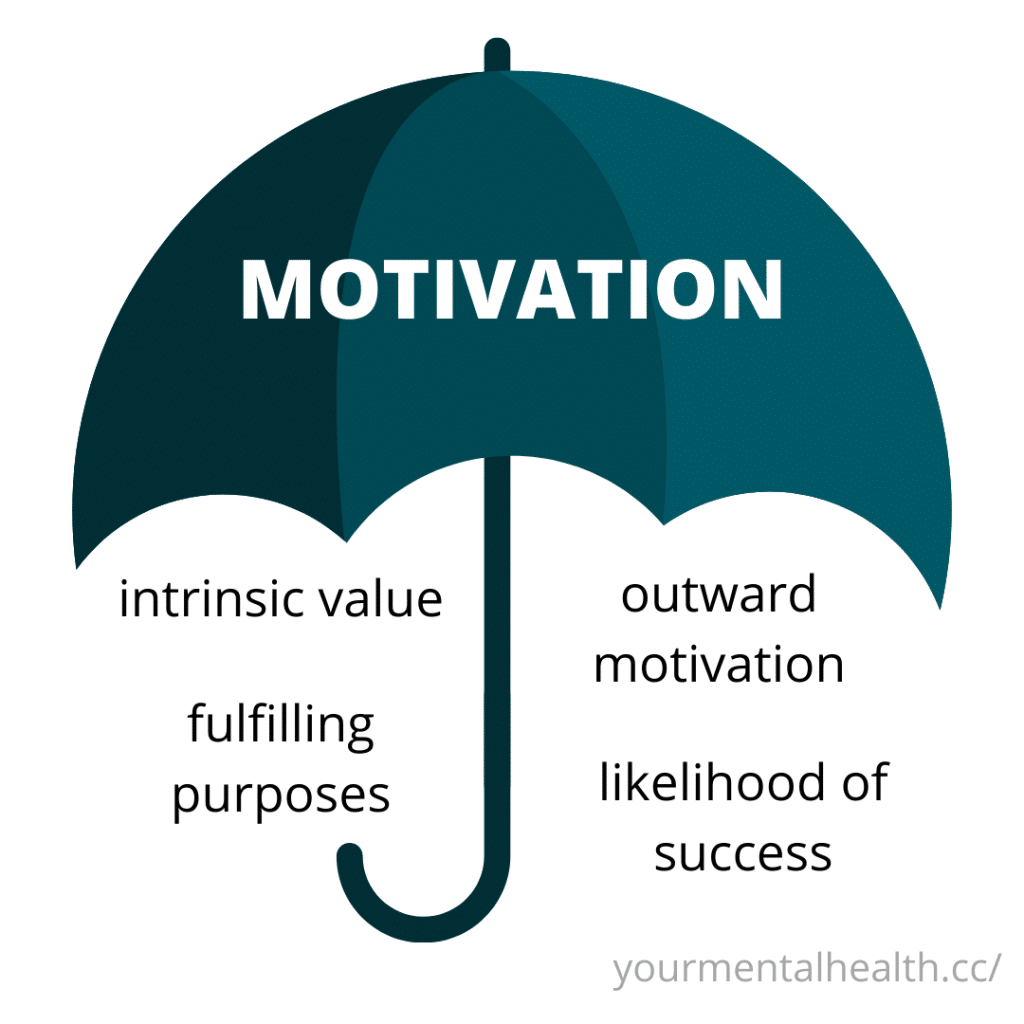
Any individual component of motivation is not responsible for what we see; it's a combination of all of them, much like a group is more than the sum of its parts.
The problem is that when people say they're not motivated, they usually don't know which one of these factors is wrong.
What happens is that sometimes we have a single objective that we seemingly can't achieve, but most often than not, we mistake where the problem is. So, for example, someone that says they're too ugly to date; the problem is probably in their self-worth and consequent confidence, not actually in their appearance.
Also, motivation is a term that is designed from external observation. If you look within yourself, you won't find motivation; you'll find emotions, desires, etc. So even if you talk to someone motivated, they probably won't say they're highly motivated; instead, it's more of a profound feeling that keeps them going.
Motivation has proved to be a popular topic lately, with several different success Youtubers and lifehacks around the internet. It isn't uncommon to scroll through your timeline and find a "recipe to success" video or article. The problem is that they won't be able to tailor their advice to people consuming this content that doesn't necessarily apply to them.
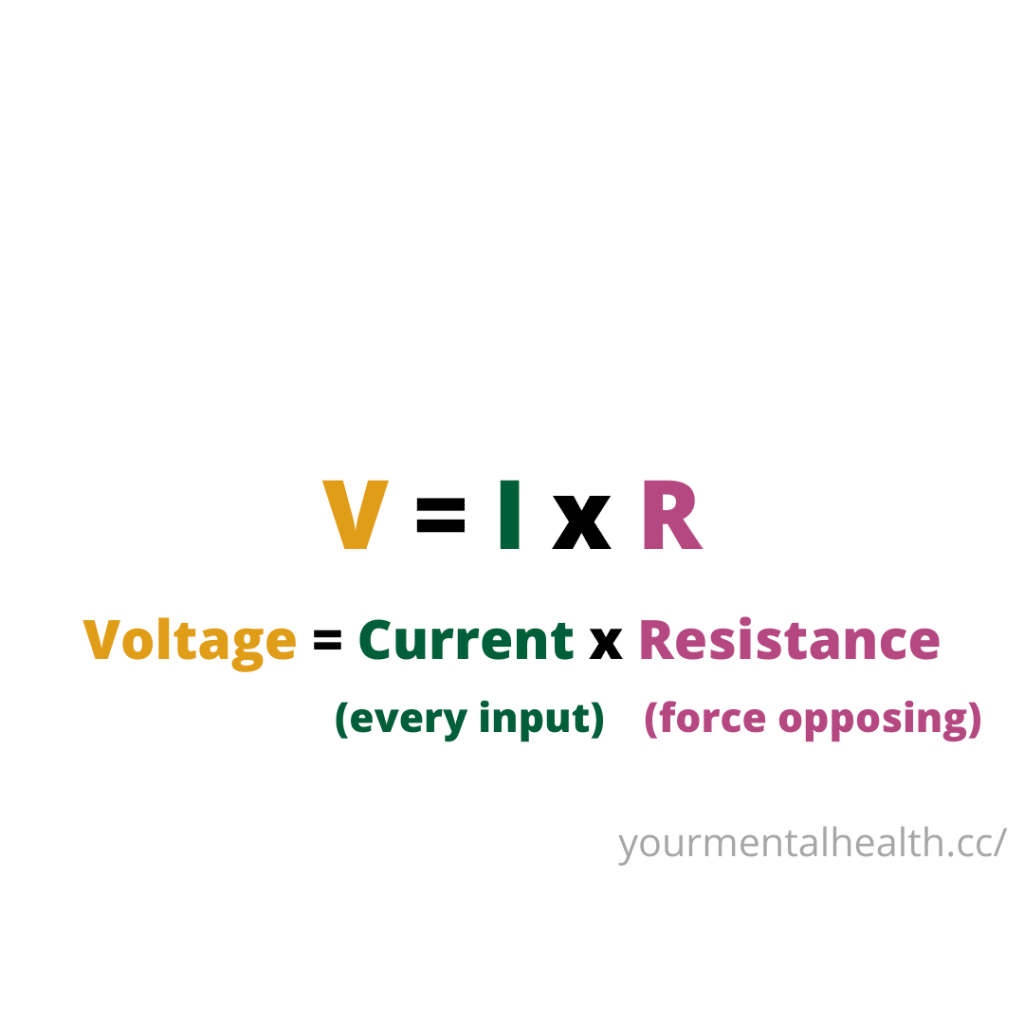
We can understand motivation under a basic premise:
This is Ohm's Law, and it makes a lot of sense when applied to motivation.
The I stands for current, and it's what we put into the circuit; it's the energy input. The R stands for resistance, and it's the force that the current has to act against; it's a force opposing what we're trying to do. Finally, the V stands for voltage, and it's the potential difference from the start point to the endpoint.
When we translate this equation in motivation and psychological resistance terms, we end up with this:

To better understand this, we can reflect on human behavior. When we think about a behavior, there's the intent that people put in; the resistance they have to overcome; then the action they take towards the end. These are the three dimensions of goal-oriented behaviors.
Most people have a problem with goal-setting and motivation because they don't understand that all three of these things can be acted on.
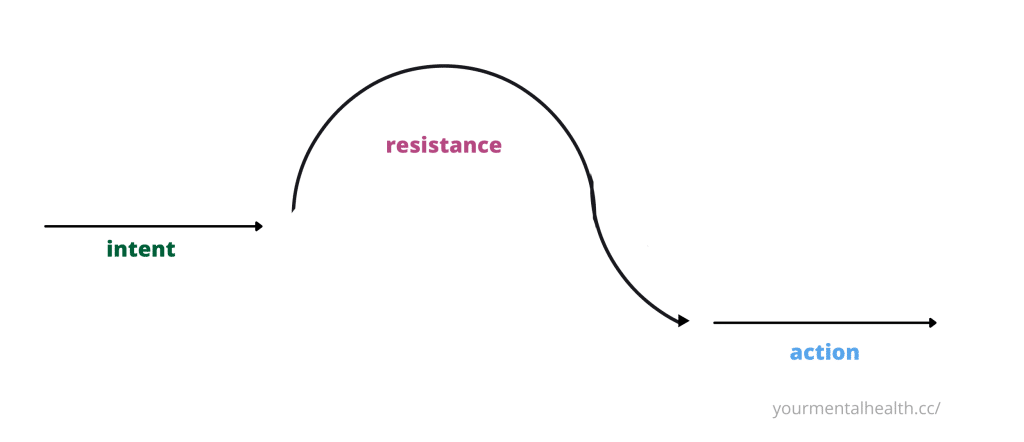
In its turn, willpower is a limited resource that you can use to power through this equation. I can expend a certain amount of willpower to overcome this resistance hump and take action one time. I can still keep using a significant amount of willpower to overcome the resistance, but it's not sustainable.
We see this pattern, for example, with students that aren't happy with what they're doing. They can start the semester with a full-charged "battery" of willpower and use it to study for the first month, but they're burnt out and unhappy by the end of the semester.
That's why we'll focus on understanding intent, resistance, and action.
The intent comes from desires ("want to do"), pressure from others ("should do"), values, or duty/obligation.
Examining these four types of intents, we understand that many times the goals that people have for themselves aren't truly their goals.
One example is people that have successful jobs but aren't happy with what they're doing. They may have a particular thing (in this case, the job) that they feel they should do, but they value something else.
So often, what keeps people stuck is that their intents are not clarified. As a result, there's a conflict of intents, and this is why they stay stuck.
When people are stuck, they're often ambivalent. They're on the fence and conflicted, which means that there's a pro side and a con side to their behavior. Many times, people cannot see the pros in their current behavior, which leads to self-judging.
For example, someone that plays video games all day instead of studying. They feel conflicted and don't see a pro side maintaining their gaming, so they feel stupid and lazy. But there's actually a benefit from gaming all day.
Our brain is continually making calculations on the costs and benefits of our behavior and the likelihood of success.
From this calculation, we opt to act or not.
One of the ways to follow a path that'll motivate us is to clarify values and desires so that we can engage in the correct behavior. Clarifying ambivalence and understanding our behavior leads us in the right direction.

When someone has a clear intent and tries to engage in a problem, the more resistance there is, the less likely they are to engage in this behavior.
The two main contributions to resistance are emotions and ego. It mainly manifests as "stuck behaviors"; for example, when people watch Youtube all day, do drugs all day, procrastinate, etc.
People usually do this to keep themselves in the present and shut down negative emotions.
The worst people feel about themselves, the likelier they are to engage in these behaviors.
We often understand what we have to do to change our behavior; we just don't know why we're unable to do it. This is due to our blindness when it comes to our resistance.
Recognizing our blind spots in terms of emotion is how we overcome our resistance.
We could compare resistance to a clogged pipe. Most people pump more energy and effort into one end of the pipe to achieve their goals, but this only leads to burnout and frustration.
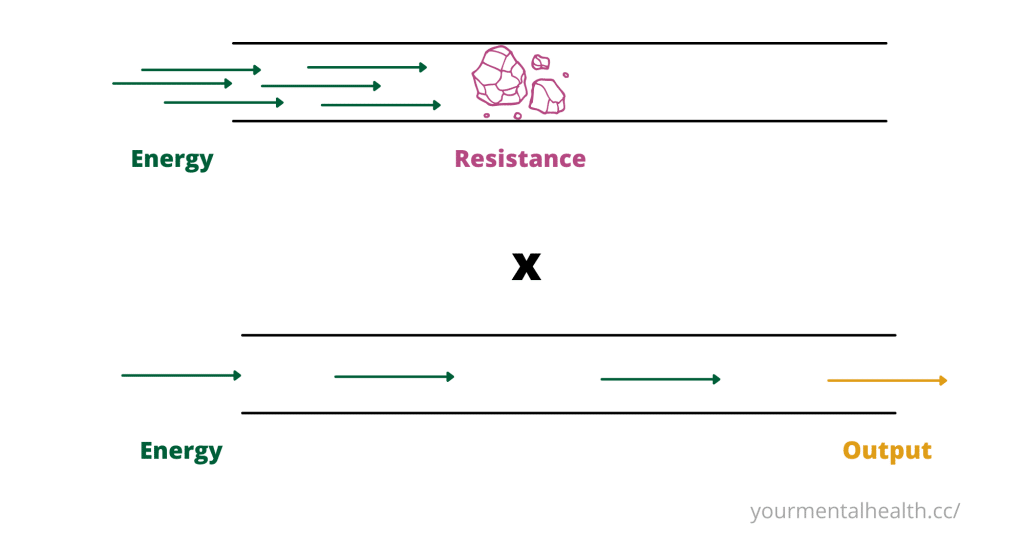
Instead, a more functional solution is to reduce the resistance and clear that blockage. Then, suddenly, the amount of energy dispensed is less, and you get more out of it.
Setting the right kind of goal is really important. We can take a few defined steps to make this happen:
There are different reasons why people choose their goals and do what they do.
Some of these result in a loss for us, making us give something up; others result in a gain for us.
Another dimension to consider when examining intent is the external reward and internal reward.
External rewards include bodily satisfaction or pleasure. Internal reward involves personal satisfaction and does not have to involve prestige or bodily satisfaction.
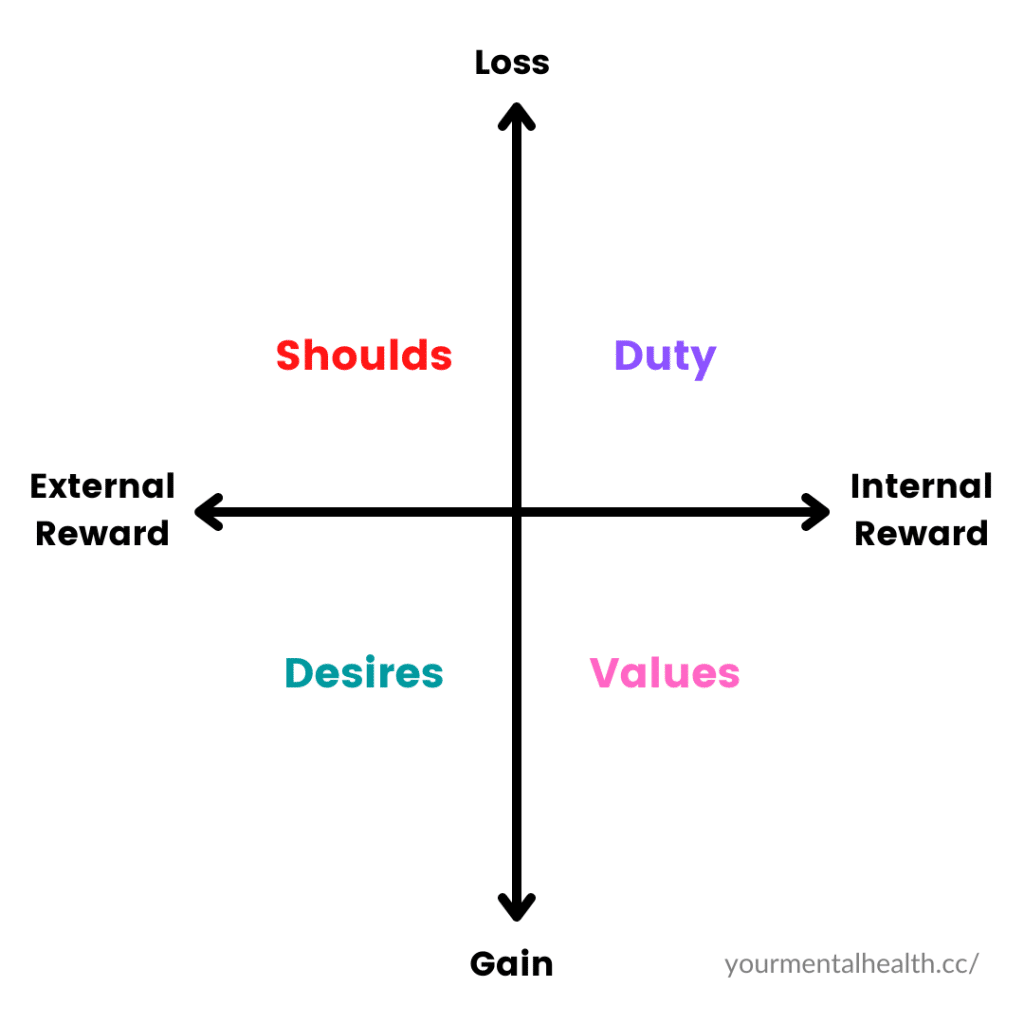
Most people operate from the left side of the quadrant, so they are living from "shoulds" and "desires." This can sometimes make people happy, but it's living a life of external reward.
When people move from the left to the right quadrant, the motivation moves in a positive direction. We will feel good about ourselves and we will take control of our lives.
To move to another quadrant, we need to create awareness and understanding. This way, we can connect with our values and understand where our intent comes from.
If we can uncover what about our actions aligns with us, "should" is not so vague anymore and it increases the internal reward it brings. Creating a plan of action that aligns with our values will then result in a positive change.
When we first create our goals, we often do not think of the other emotions involved and what it takes to reach that goal.
It is important to raise awareness of the negative, because it helps in the following ways:
The primary emotions that people feel when they think about fulfilling their goals involve overall positive emotions like excitement, achievement, and pride. This is the default reaction when people first create goals.
When people think about goals in a positive way, an expectation is created. Then after taking action, their expectations are often unmet, and motivation decreases. This is why it's important to raise awareness of the negative.
For example, we want to lose weight. We are excited and pumped when we decide that we want to become thinner. But when we go to the gym, we have difficulty doing the exercises. Not only that, we see thinner people than us there. After a week of working out, we still don't see the expected results, our motivation plummets, and expectations shatter.
When we raise awareness of the negative, we can begin to set realistic expectations.
Setting inappropriate expectations will only tank our motivation and lead us to quit. This can make us feel ashamed and think of ourselves as quitters. This cycle happens really fast, and it begins with unrealistic expectations.
As we learn to expect appropriate events and results, it'll disable the cycle and help us become more motivated.
There is a conflict that exists between the quadrants and the four types of intent that can be seen as ambivalence. Ambivalence is when we're sitting on the fence.
We often think about what we want to accomplish, but we don't really appreciate what keeps us from accomplishing it.
When we're stuck, there's always a pro in continuing the behavior that keeps us from our goals. That is where our brain tends to focus. For example, we want to get good grades but we play video games more than we study.
By raising awareness of the negative, we highlight the cons. This helps us understand what's on the other side of the equation instead of just focusing on the pros.
In highlighting the negative and clearing the ambivalence, positive change can begin to happen.
We can't move past ambivalence and internal conflict if we don't know what the internal conflict is.
We need to understand that we make a choice every day and that it's up to us to choose who we want to be. Do we want to live a life that is in service to our "values" or our "shoulds?"
Once the cost of a behavior increases in our mind, you would think that it would decrease the likelihood of us engaging in this behavior.
However, increasing the cost can sometimes drive behavior.
This may seem like a paradox, but take wine tasting for example.
People have done studies on wine tasting, and they found that when you don't tell the price of the bottles to wine tasters, people can't tell that the priciest wines actually taste better. Now, when wine tasters do know the prices, they rank the pricier wines higher. Interestingly, the price drives the perception of quality and value.
To put that into the perspective of goals, if we want to quit gaming, for example, we need to recognize the costs it will entail - that is, we'll feel shame, loneliness and boredom.
Once we're aware of the negative costs and have a realistic expectation, the first steps toward our goals will not seem as bad ("it wasn't that bad"). It then increases our motivation to continue that behavior.
There are 2 ways we become aware: objective information and subjective understanding. Subjective understanding is responsible for changes in behavior.
The information does not change behavior, but understanding does.
In science, different types of memories have the same idea.

The "shoulds" come from explicit memory and they don't drive our behavior.
Implicit memory results in impulse control. This type of memory is not a fact, it's an understanding that was literally processed by your brain.
This is why raising awareness helps people to do a behavior later on. It's not because you were told to do it, but because you were made aware of it.
A lot of times, people know what they need to do but they don't know how to do it. They'll even think of themselves as lazy, undisciplined, or unmotivated.
People often describe themselves this way because they look inside to see themselves struggling to do something and they'll observe someone else's successful external behavior without understanding their emotional struggle. They tend to compare themselves to others and unconsciously create resistance towards their goal.
We can spot signs of resistance when we hear phrases like:
These are what peoples' thought process manifests as, but this is not the problem. This is only a manifestation of resistance.
Resistance can also include cognitive biases and schemas.
It's hard to recognize our own biases. People can recognize their cognitive bias in some intellectual way; they can know their biases from an explicit memory standpoint, but it's harder to understand it implicitly.
These statements come from
Past experiences come with emotions. When we have an unpleasant experience, many times we just distract ourselves to overcome it and the emotions go dormant. Our brain then scans the present moment and the emotion returns the next time you engage in a similar situation. So even though it's a new experience and circumstance, we feel like something will go wrong.
Emotions that cause people to resist taking action: fear, hurt, shame, pressure, embarrassment, guilt, alienation, frustration, powerlessness, hopelessness, loneliness, anger, resentment.
The avoidance of these negative emotions motivates people to stay stuck.
People that are stuck are not lazy. They're, in fact, really motivated, but they're motivated to do nothing.
"Being stuck" does not mean one set scenario. It can mean differently to people. You can be in a relationship that you don't enjoy because you think you won't get anything better than what you currently have. Or maybe you're in a six-figure job, but don't feel happy on a day-to-day basis and are unsure how to change your life.
Over time, as we develop negative experiences, we develop an ego that protects us from negative emotions.
When we feel insecure, we tend to compare ourselves, over rationalize, and pump ourselves up by putting other people down.
Many times, people have a sense of identity that prevents them from acting. They've built a construct of themselves that doesn't allow them to succeed. Who we are factors into our perception of success.
Our brain makes the following calculation:

If we have an identity that views us as a failure, this identity destroys our motivations.
One of these built identities can be of a victim. When the person thinks of themselves that way, then they don't have to take responsibility and face negative emotions.
First, we can uncover the emotion and then metabolize it. This is also known as "emotional catharsis." That's when things become implicit memory.
Secondly, we can redirect the neuronal pathway. This means that our neurons tend to follow certain paths; human beings have scripts running through their minds.
As we uncover our emotions, we can redirect our thinking in a more positive way. Over time, our way of thinking becomes more and more solidified.
Through questions and reflections, we can start thinking about things in a new way. When we reinterpret our understanding, we will actually redirect our neuron pathway and begin the change.
Focusing on patterns rather than outcomes is one of the ways to become more action-oriented. The question is stated as, "What's the pattern here?"
For example, when someone adopts a diet but after four days, "cheats". This comes from a number of judgments, like "I failed", "I'm undisciplined", etc. However, what you should be focusing on in this situation is the pattern. Why were you able to succeed for 4 days? What happened on day 5?
This way, you'll better understand the reasons behind your actions. The responsibility of the success or the failure is no longer on the person. It now has to do with the actions and the environment.
There are several reasons why people create goals. Most people set goals based on what others are doing. Others choose goals for achievement; they think about the end of the road and the target. Others choose goals because they are chasing a feeling.
More often than not, goal-setting is not systematically created and that is one of the problems. We create unreal expectations and ideas.
Here, we want to recognize where we are and where we want to go. Pinpoint the halfway point between that (50%) and then further narrow down the halfway point between that (25%).

There are a lot of things that we engage in when we do this process.
Our brain can measure the progress towards something. When the gap between what we're capable of and what we want to achieve is wide, it decreases motivation.
Because of that, the first thing we're gonna do is shrink the goal to the first target. This way, we increase the likelihood of positive reinforcement and we open ourselves up to being successful.
To give an example, someone wants to become healthier. The person can ask themselves what they did last week. They realize that they didn't exercise and ordered take out every day. They acknowledge that this is their baseline and they must think of a reasonable goal for next week. They might then decide to work out one day during the next week, and this will be their first target.
There are a number of different kinds of scientific principles that we can leverage to optimize how to set a goal.
1. Explore your options
Giving yourself a single path to follow and telling yourself to "just do it" won't work in the long term. It often invalidates your situation and tends to come from a gut reaction. If you want to engage in a behavior, instead of giving yourself a set solution, explore options to choose from. You will likely gravitate towards the most doable scenario.
2. Operationalizing
Operationalizing a problem means breaking down a problem or making something concrete. It increases the number of achievable steps. We have this part of our brain called the frontal lobe that is good with operationalizing. The frontal lobe is responsible for executive function, which is the ability to plan and execute tasks. For example, if we ask a 2-year-old to clean their room, they won't be able to, because their frontal lobe can't grasp this abstract request yet. What we need to do is break down "clean your room" into tasks, like "put away your books" and "put your pencils in the box". This is the process of executive function. It's difficult to do that, but it helps us define achievable steps. As we practice, our brains will be able to operationalize much better.
3. Dunning-Kruger Effect
When we learn how to do an activity, we start where we're unconsciously incompetent, move to conscious competence, and finally end up at conscious incompetence. In this last stage, the behavior becomes easy and natural to do for us.
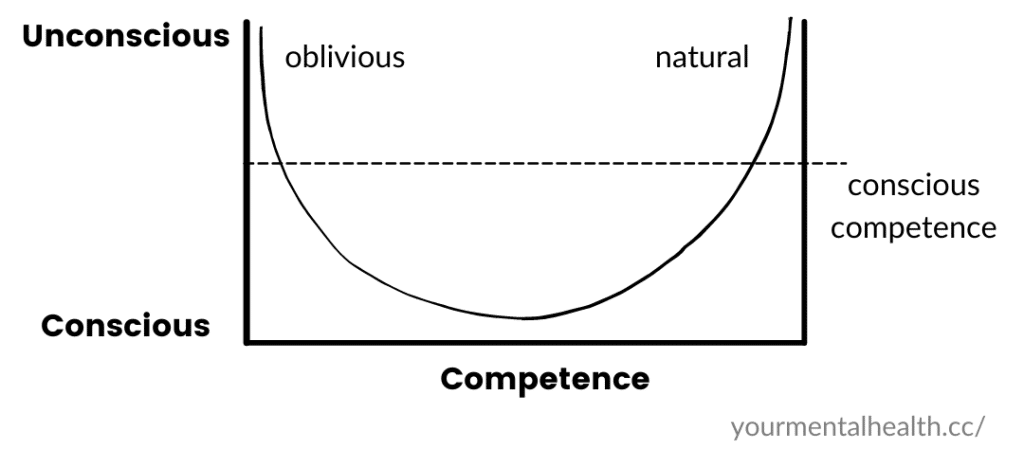
A lot of times, when we want to achieve our goals, we want to move from unconscious incompetence straight to unconscious competence. We want to emphasize the conscious thought process, problem-solving, and mindfulness. In doing so, we start thinking methodically and critically. Our understanding will precede the change that we want to bring about.
There are several difficulties surrounding goal-setting. Here are common challenging scenarios:
This approach is not meant to make us achieve our goal, but to iterate. Success is not our target, learning is our target.
Sometimes we'll succeed, and other times we'll fail. What we should do is analyze why we failed.
Oftentimes, when we have goals and fall short on them, our emphasis is on the failure, and what we could do better. However, the interesting thing is that the recipe to success is not necessarily on what we could do better, but on the number of times that we already succeeded.
This is known as the principle of positive deviance, which says that if you're trying to fix a problem, don't focus on the attempts that failed, but on the attempts that you succeeded.
When we think about a goal, there's a lot of value to be gained from breaking apart motivation into multiple things. We can adjust the levers and increase the precision in which we can make changes.

What we're gonna do is expand the precision with which we look at a goal.
Here are the dimensions of a goal. Each of these dimensions can be changed and adjusted to help us gain success:
1. Target
This is what we think traditionally as the goal.
This is where the 25% rule comes in.
2. Actions
This is where operationalizing comes in. Oftentimes we set goals that are not actions, so to explicitly take a goal and reduce it to action will make things easier to do. It will turn the abstract into the concrete.
3. Examples of success and failure
We can explore how we feel about our attempts, successes and failures. What are the key takeaways from these experiences?
Once we make these conscious, we have increased our ability to engage in them again.
This is also an opportunity to explore our resistance. We can ask ourselves "What got in the way?"
4. Physiologic factors
People could have circadian rhythm disorder, vitamin D deficiency, thyroid dysfunctions, testosterone deficiency, vitamin B deficiency, or others.
There can be a number of physiological factors that go into motivation. This is also where sleep, diet, and exercise come into play.
5. Psychological stressors
If you're overwhelmed or stressed, or had a bad interaction at work, that's gonna impact your RAM (working memory). There are all kinds of psychological stressors that can contribute to you not achieving your goals.
You can reflect on what's been stressful for you in the last week. And when things get stressful, how do you think that'll affect your ability to meet your goals.
Generally speaking, people tend to come to the conclusion that "if I were better", "if I could manage stress better", "then I would succeed". That implies that the failure is theirs.
But by pointing out that there are psychological stressors that'll make our life hard, it's easier to forgive ourselves and have self-compassion.
Maybe the solution is not to increase our willpower, but to set better boundaries with people who create stress in our lives, for example.
6. Social influences
This dimension can be parents, roommates, friends, significant others, etc. Here we can explicitly understand the influence of different people in our life.
Who are the people that we hang out with? What do they inspire us to do?
The goal is to be consciously aware of this dimension. When we hang out with our friends, what do they inspire us to do?
Some questions we can ask yourself is "who holds you back?", "who pulls you forward?".
There are some revelations that may appear when we start asking ourselves that.
7. Environmental influences
An example of this dimension is our access to cell phones. Where is it while we're working? Is it locked? Is it in your pocket? Do you have notifications on?
How do you get distracted? When do you get distracted? Where do you study?
Here we want to think about the environmental influences that lead us to success.
8. Stakeholders
What are the different stakeholders for the goal that we're trying to achieve?
Sometimes, for the goals that we have, there are other people that don't want those goals. For example, if you're trying to get promoted.
There are things outside of us that are going to be influencing us, and consciously thinking about those things can help us adapt our goals and actions.
References:
The article fits more for the kind of people that meet the following criteria: people confused by inner turmoil, that feel that other people do a lousy job at relationships but have a hard time articulating what they're doing wrong, someone that feels cold or numb in a relationship, keeping others at arm's length. It happens most commonly for men due to the way they get raised and conditioned.
From a partner's perspective, this looks like receiving mixed signals, such as your partner getting in a mood but saying nothing is wrong. Other times, the partner gets mad over small things. Lastly, the partner keeps you at arm's length. Again, this pattern is most common with men.
The Attachment Theory was created by John Bowlby, where he studied a "strange situation.” In this situation, a kid is with their mom, who leaves, and then a stranger walks into the room. After a while, the mom enters the room again. There were different ways in which a kid responded to this situation.
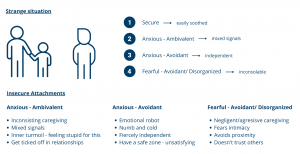
The Four Types of Attachment
1. Secure attachment
The kid may cry or be in distress when the stranger enters the room, but they’re easily soothed when the mom comes back.
2. Anxious-Ambivalent
The kid cries, but when the mom comes back, they get frustrated, angry, and confused.
3. Anxious-Avoidant
The kid cries as well, but they don't go to the mom for comfort when she comes back. They become independent.
4. Fearful-Avoidant/ Disorganized
They freak out when mom leaves the room, and they become inconsolable, even when she gets back.
The anxious-ambivalent attachment style develops when caregivers give inconsistent responses and care giving to the child. Sometimes the caregiver is warm and loving, and other times they can be cold, distant or neutral. That way, the child never knows what to expect.
Children learn to feel their emotions by mirroring other adults; they know what they're feeling through the emotional expressions of people around them. So it gets confusing when they receive inconsistent responses from their caregivers.
The type of care these people received during their childhood results in a clinical presentation of mixed signals, either external or internal. One example is that a person can be mad and send signals that they’re angry, but they say they’re fine when asked how they feel.
Consequently, the people with this attachment style feel inner turmoil. They get angry or frustrated and feel stupid because of it. They can be ticked off in a relationship, but they cannot articulate why they’re bothered.
Another trait that can be found in people with this attachment style is low self-esteem.
Relationships can be challenging for anxious-ambivalent people because when something upsets them, they can't communicate to their partner what they did wrong. What happens is a sense of self-judgment, where they feel like they shouldn't feel this way. The person ends up not sharing their feelings, and it creates problems in the relationship.
The anxious-ambivalent attachment style is called a resistant attachment, characterized by feelings of anger and helplessness. The people who have it seek contact and also rebuff it, so there’s a part that wants more in a relationship and another part that doesn't want to get hurt again. It's a protective mechanism that the person engages in.
This can also lead to an intrinsic lack of motivation because the person is on the fence about things they want, afraid of not getting it.
The anxious-avoidant attachment style is caused when a child communicates their emotional needs, but they get no response or a neutral response from their caregivers. Basically, they learn that voicing their needs does not get a good response.
The people that present this attachment style can often feel like "emotional robots". These people are seemingly numb, cold, and fiercely independent.
The way they were cared for as kids creates a problematic cycle where even if the person communicates their needs, they're not good at it, so they feel rejected. The more rejected they feel, the more independent they become, and they end up withdrawing. They withdraw but don't leave, staying at the threshold of a relationship.
In a relationship, anxious-avoidant people have a safe zone where they stay independent. However, the safe zone is unsatisfying because they realize they're missing something in the relationship but don't know what to do about it. Because of this situation, they keep their partner at arm's length.
It can even happen that the person is afraid of being dependent on their partner.
They may appear calm, but it's a mask for their internal distress, protecting them against emotional hurt.
This attachment style mostly happens to men because of the way they were raised, with commonly repeated phrases like “boys don’t cry” or “man up”.
The disorganized attachment style carries different names, depending on the author. However, it’s believed to be the most difficult kind because of its origins and characteristics, as it can be a result of childhood trauma and abuse.[1] [2]
This attachment style develops when a caregiver constantly fails to respond accordingly to their child’s distress, often in a negligent or aggressive way. When that happens, what was supposed to be a source of safety for the child becomes a source of fear and unreliability; they don’t know what to expect from their caregivers, and don’t know if their needs will be met.
As an adult, the person with disorganized attachment fears intimacy and avoids proximity. They’re waiting to be rejected and hurt by their partners, and view their attachment figure as unpredictable.
The person with this attachment style also exhibits characteristics of anxious - avoidant and ambivalent styles and can feel like they’re ineffective or helpless in life. They are at a higher risk of developing mental health issues such as substance abuse or aggressive behavior.
The characteristics of a disorganized attachment style can lead to self-sabotage or to a self-fulfilling prophecy, either when the person starts seeing signs of rejection that aren’t there, or when they choose a partner that induces fear, confirming their belief that they can’t trust others.
In a relationship, these people worry that their partner doesn't love or support them, and they can alternate between clinginess and detachment.
What Bowlby hypothesized is that all this happens in childhood. That's not true, because 'foundations are not fate.’
When you're 1 year old, the attachment style is totally determined by your caregivers. As you grow up, this matters less and less, and what really starts to matter is the selection effect. People play an active role in selecting and shaping their interpersonal environment; however, they still might choose based on what they learned from their parents.
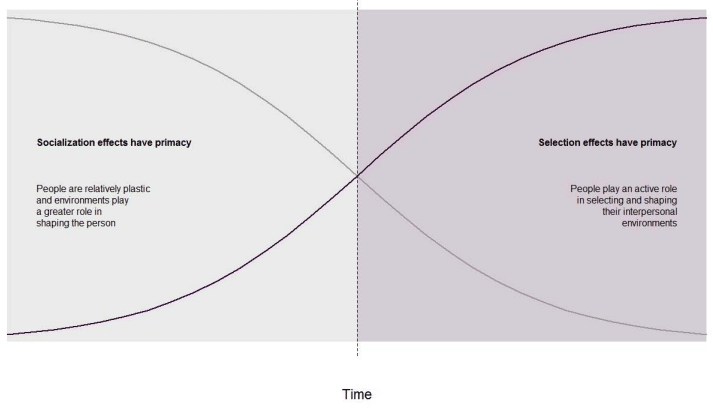
If you have any kind of insecure attachment as an adult, you should share your feelings, even if you don't understand them, and the partner can be confused with you. Fixing your attachment style is not about figuring out the answer; it’s about not facing your problem alone. It's about emotional mirroring, not emotional correction. It's about the other person meeting you where you're at. That's why you should be careful with the people you hang out with; try to find people you can share a half-baked thought with.
Another step is to acknowledge your own emotional needs, even if you don't understand them. Acknowledge whatever you can. Understand that your partner doesn't need to fulfill your emotional need, but it's essential to accept and communicate it.
Fixing your attachment style has to do more with awareness than changing your behavior. It’s about acknowledging your personal needs and sharing them for emotional mirroring with other people. The partner needs to hear you and mirror it back.
Recently, a paper[1] came out stating that half of the adults with ADHD experience or have experienced a substance use disorder. Alcohol use disorder is most common among adults aged 20-39, followed by cannabis use disorder and other drug use disorders. In addition, more than one-quarter of those with ADHD experience major depression.
To understand ADHD better, it's important to know that it's a disease of executive dysfunction. Our executive function is our brain's capacity to plan and execute tasks, inhibiting certain behaviors and impulses in order to do the task.
The first thing is that people with ADHD have a deficiency in their behavioral inhibition circuitry. Secondly, they have altered sensibilities to reinforcements, which means that things that are low-hanging fruit and easily enjoyable are far more enjoyable to people with ADHD. They'll prefer more instant gratification. Thirdly, people with ADHD are more impulsive, meaning that when they have an impulse, they're much more likely to act on it, correlating to the other aspects of ADHD. The impulsivity also relates to intolerance to delayed gratification.
The ADHD brain is very vulnerable to substance use because of these three things.
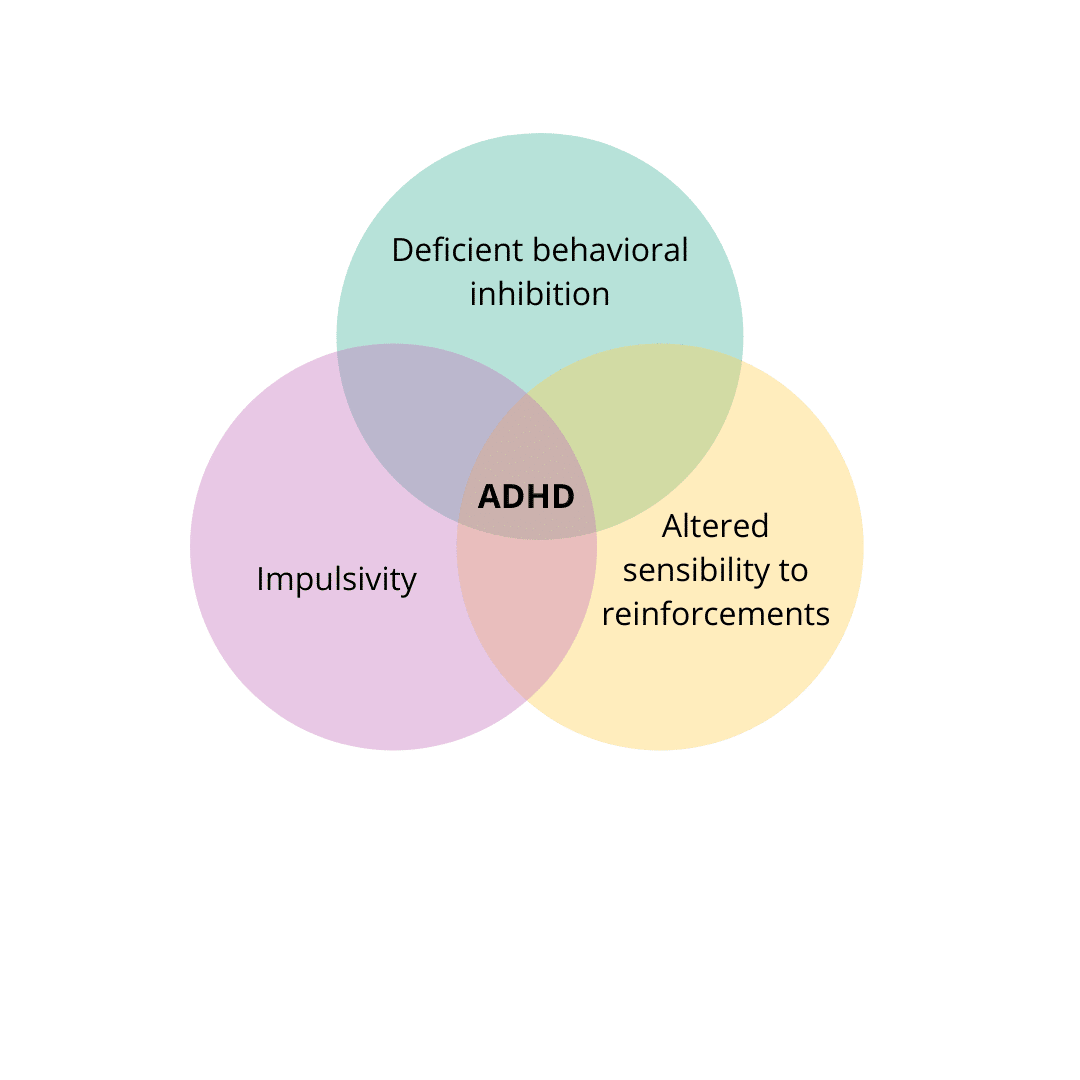
There are different areas in the brain related to ADHD.
One of the most affected ones is a part in the front of your brain called the Prefrontal cortex, which is responsible for inhibition.
Another part is in the center of your brain, called the Anterior cingulate cortex. Its dysfunction results in poor selective attention and low inhibitory control. People with ADHD have reduced activity there.
People with ADHD also have impaired dopamine activity across the brain.
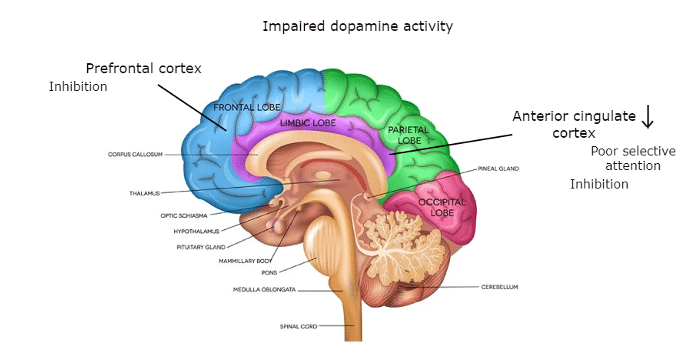
Essentially, what happens in the ADHD brain is getting too many thoughts too fast; the brain is not able to turn down the volume of some thoughts.
By giving people with ADHD stimulant medication, you're stimulating an area in the front of their brain (Prefrontal cortex), increasing inhibition and allowing them to focus on one thing. The medication will also increase dopamine levels.
Baseline low dopamine generates ADHD symptoms, and taking drugs will increase the dopamine activity, resulting in almost self-medication. The problem is that this effect is temporary, and it leads to other impacts, like the stimulation of the hippocampus. Over time, it'll affect the part of our brain called the striatum, decreasing dopamine and making ADHD worse.
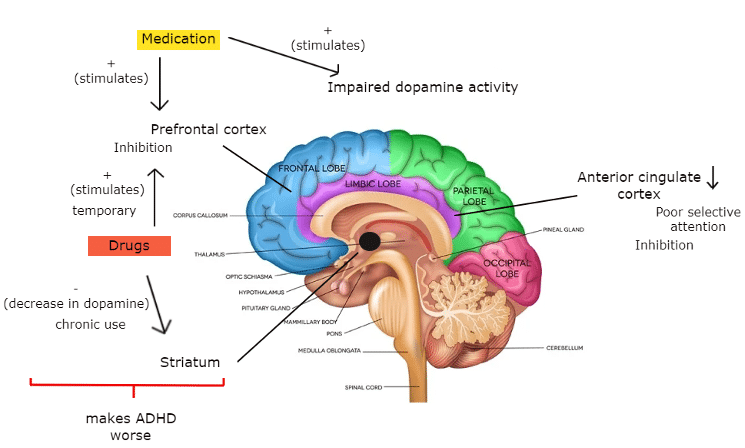
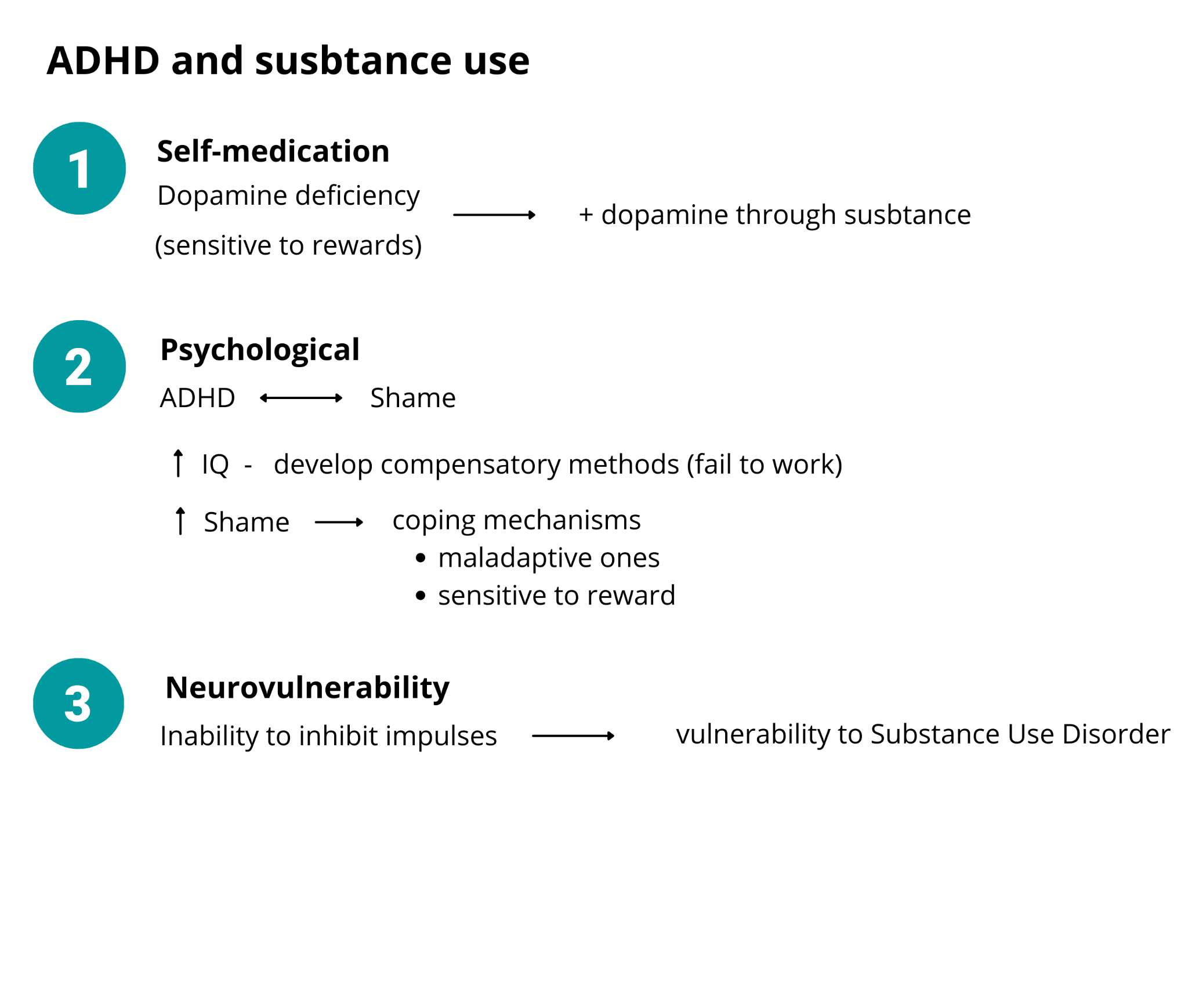
The first reason why people with ADHD use substances is to self-medicate.
The ADHD brain is dopamine deficient, which is part of the reason why they're sensitive to rewards.
Drugs will increase dopamine in the brain for a while, and that's also why ADHD medicine is a stimulant.
The second reason is psychological.
ADHD is associated with shame; many times, people with ADHD don't understand they have it, and they just feel like they're busted in some way.
Often, those people have high IQs, and they end up developing compensatory methods that require a lot of effort to "keep up" with others. Over time, these compensatory methods no longer work, resulting in more shame. The more shame you have, the more you need coping mechanisms. Then, because the brain is sensitive to rewards, the coping mechanisms end up being maladaptive, such as drugs, video games, or social media.
The third reason is neurovulnerability.
The alterations in the ADHD brain lead to an inability to inhibit impulses, leading to vulnerability to substance use disorders.
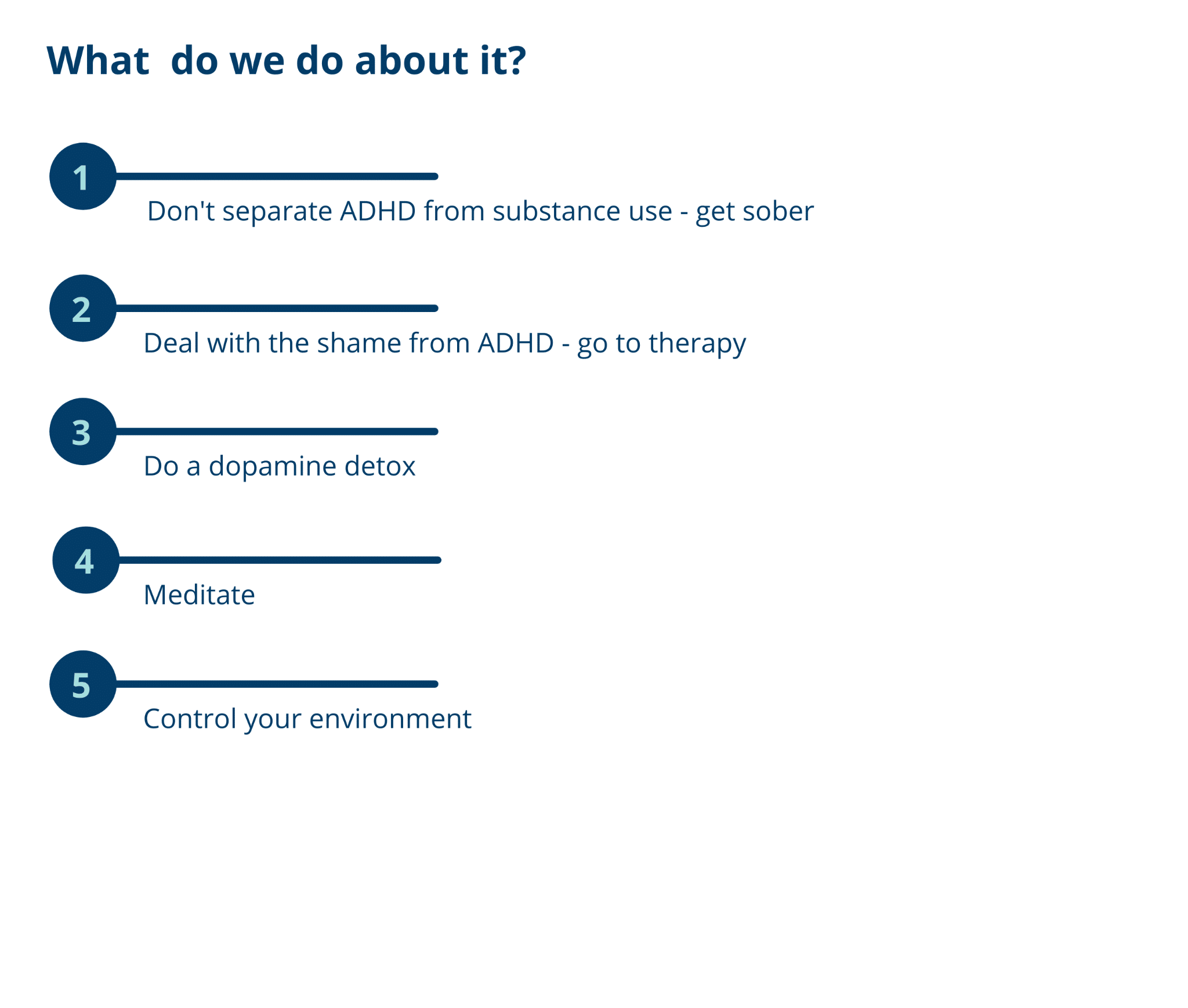
The first thing is to stop separating ADHD from substance abuse. Suppose you have a motivational problem or ADHD and use any kind of stimulating substance. In that case, this cycle will keep going in your brain, making it hard to be motivated. The substance will contribute to the problem, making it essential to get sober.
You have to deal with the shame linked to ADHD. That's why psychotherapy is a good idea. It's necessary to deal with the feelings that make you reach for that substance.
Do a dopamine detox. Substance use is literally making ADHD worse. You have to give yourself a chance to reset whatever your natural dopamine circuitry is, so you can start responding in healthier ways.
You have to meditate. All of the solutions are basically removing bad things. The one thing you can do to add is meditating. Meditation strengthens your frontal lobe, strengthening the control of impulsivity.
Recognize that you're prone to certain weaknesses based on your environment, so it's crucial to control it. For example, social media and video games are gonna pull the person with ADHD's brain much more than a neurotypical person. Because of the lack of impulse control and the sensibility to reward, it's like you're walking a tightrope, and any gust of wind can blow you off course. That's why it's essential to control your environment.
For every hundred deaths, one is caused by suicide.[1] The numbers go even higher for those who try to take their own lives.[2]
The Centers for Disease Control and Prevention (CDC) has dubbed suicide as one of the top reasons people die. Thus, it has already become a significant public health concern.[3]
It’s crucial to take any mention of suicide seriously even if not all suicide-seeking behavior is intended to kill. Sometimes it is more like an invitation for mental health support. They’re not fully committed to seeing it through.[4] For example, a patient called Dr. Alok Kanojia or another friend after she overdosed on pills to let them know what she did.[5] A study found that talking to the person about the matter and using active listening can help reduce the risk of suicide and give them hope.[6]
There is a big chance of preventing suicide or a suicide attempt. Most people who think about it may feel hopeless about what’s happening to them. Often, they send some form of warning to the people around them before attempting to take their own lives.[7] For example, someone mentioning a desire to die, searching for potentially dangerous weapons and suicide methods, and pushing away friends and family.[8]

It is estimated that 13 people out of 100,000 each year commit suicide.[9] Sadly, many of those that attempt suicide may even go unreported. From what we’ve learned, suicide is much higher in specific groups than in most.
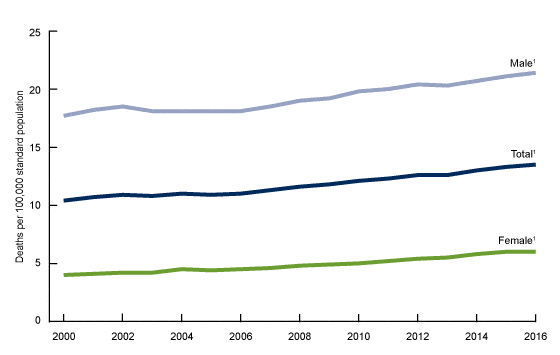
More adult women attempt suicide than men, but they are less likely to complete it.[10] Research has shown that 4 out of 5 suicides are men.[11] This is probably because men choose more deadly methods.[12] For example, men often try killing themselves by shooting themselves with a gun, carbon monoxide poisoning, or hanging. Women, on the other hand, usually poison themselves by overdosing on pills.
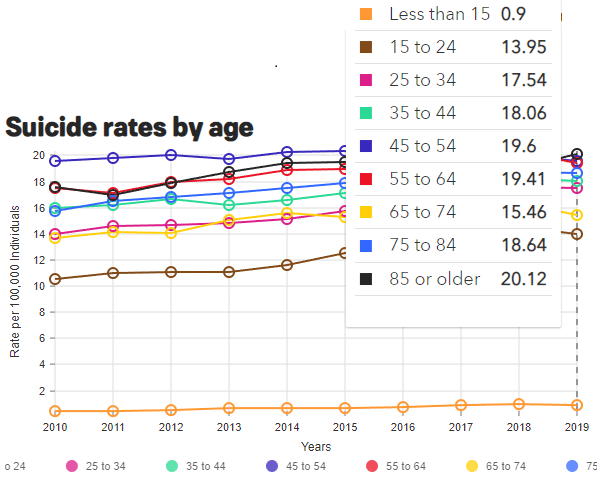
People who are 85 years or older have the highest suicide rates.[13] This is followed closely by the age groups for those 45-54 years old and 55-64 years old.[14]
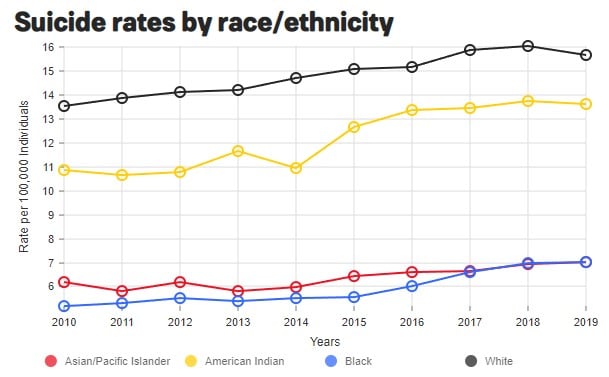
Suicide rates are the highest among those of White race or ethnicity, with American Indians and Alaska Natives as the second highest.[15]
Some adolescents treated for depression are usually prescribed antidepressant drugs called selective serotonin re-uptake inhibitors or SSRI.[16] Researchers have found that adolescents who take this drug are more likely to complete or attempt suicide.[17] Therefore, clinicians need to take extra care and attention during the first few weeks upon prescribing this drug to adolescents.
Survivors of suicide attempts are at the most risk of committing suicide. However, younger groups will most likely try again if they have either a case of alcohol use disorder or a personality disorder.[18]
There is nothing set in stone to predict who will choose suicide. These are just some of the common statistics from those who have attempted or completed suicide.
It’s believed that someone decides to take their own life because they are mentally ill
Surprisingly people who take their own lives do not have a diagnosed mental illness in many cases.[19] There can be many reasons for choosing suicide. For example, they can be undergoing a tumultuous time in their life, like a physical illness or experiencing work problems.
Remember that there is not only one single culprit. It can be a combination of other things as well.

Mental illness and psychopathology are not the only reason why people take their own lives. They can stem from different causes and it is crucial to remember that suicide is related to many other things.[20]
Having this approach will help us understand that suicide is not an illness but a symptom of something else. We list down several reasons below why someone could be considering suicide.
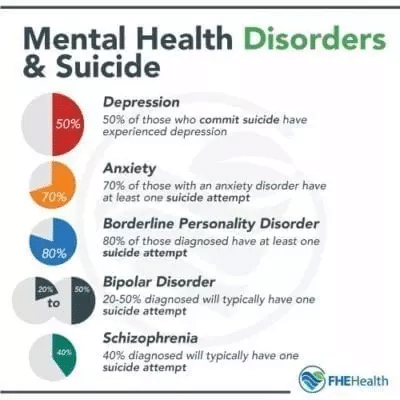
People suffering from mental disorders fall into this category. There is a greater risk for those who have depression, problems with substance use, and psychosis.[21] Suicidal behavior is also typical among people who suffer from anxiety disorders and personality disorders.
Major depressive disorder (MDD) is commonly found in people with suicidal thoughts. It is often characterized by the statement “I’m suicidal despite life being great.”[22]
People will usually have a good idea of what they want themselves to become. However, some events may break that idealized version of their lives, leading them to think that suicide is the only option out.[23] This destructive life event can even trigger a major depressive episode.[24]
An example of a ‘broken life dream’ can be a person who was accused of sexual harassment and fired from their job. He is ostracized from the community even without any proof that he is guilty or innocent. He may entertain suicidal thoughts and behavior because of his experience.
Another example of this is when a woman wants to have a child but cannot bear children. Despite trying different methods, her body miscarries several times. She may then consider suicide as a way out of her situation.
This category is characterized by the statement, “Life isn’t worth living (hopelessness).”[25]
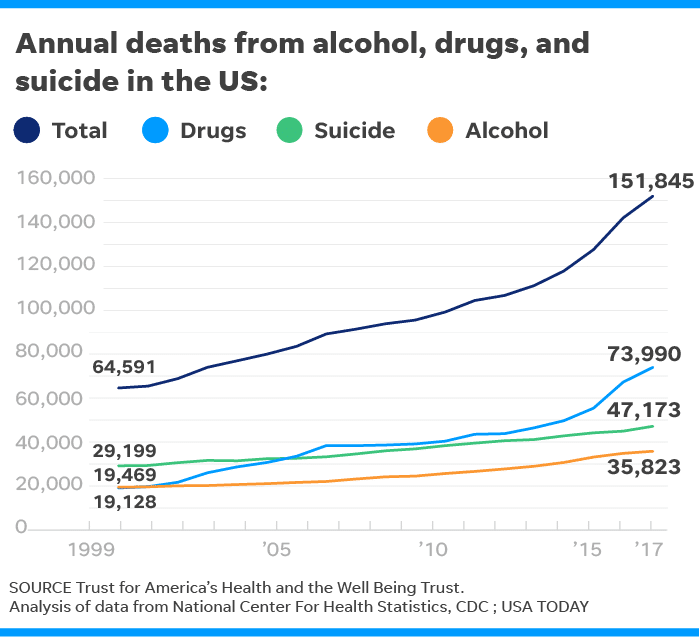
As mentioned above, one doesn’t need to have a mental illness to have suicidal thoughts. Some people may have suicidal thoughts, but one’s mind holds the pro and anti suicidal ideas in check. There can be occasions when the balance tips and the defense from suicidality fail. Usually, it involves some substance that affects your state of conscience.[26]
An example of this is when one uses alcohol. The chemicals lower one’s control, making it easier to entertain suicidal thoughts without any defenses. It may, unfortunately, end in a suicide attempt.
Some people may choose suicide as a way of expressing their anger towards themselves. This concept is backed up with Freud’s theory that explains suicide as “one’s aggression towards the self.” One feels that life isn’t worth living anymore and one doesn’t deserve to live at all. In committing suicide, one thinks they are sufficiently punishing themselves for being bad and not deserving to live and get better.[27]
This category is captured by the statement filled with anger: “I don’t deserve to live.”[28]
When one cannot control their negative emotions, there is a big chance that person will entertain more suicidal thoughts. [29] A person who cannot successfully manage their negative moods and respond well to their situation is called emotional dis-regulation.[30] Poor coping strategies can lead a person to feel ashamed and humiliated by his experiences.[31]
These are the different reasons why people may kill themselves. It’s not just mental illness that only causes suicide but a combination of several reasons.
There has been a 17% increase in suicide in the Americas Region from 2000 to 2019.[32] The use of antidepressants among adults has also increased between 2009 to 2018.[33] So it may be about time to look at something else that is causing suicidality other than mental illness.
Suppose different causes are considered responsible for suicidality. In that case, there needs to be different solutions to help people who are considering suicide.
We may be able to help more people and prevent further suicides.
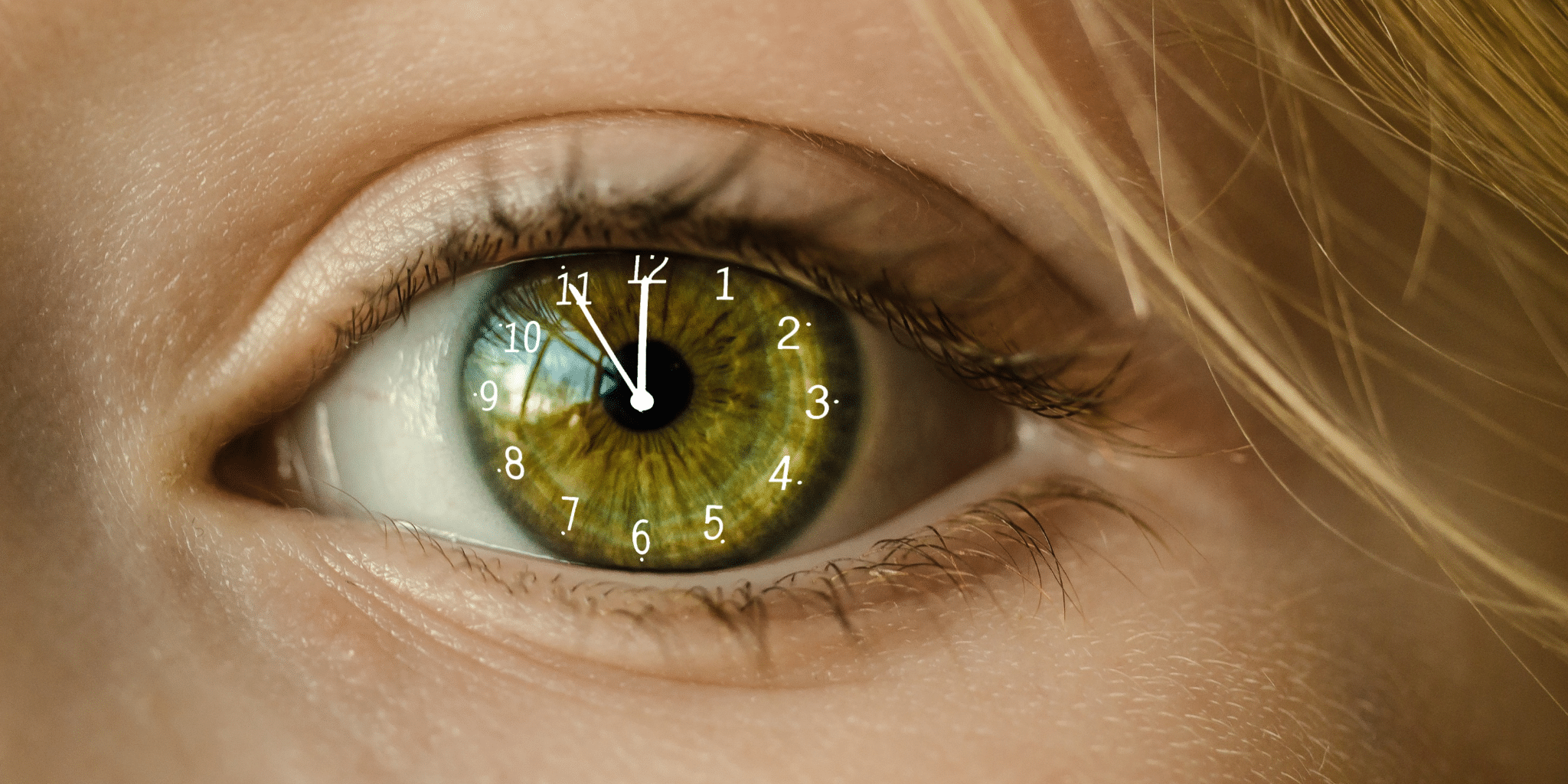
There is no one easy way to predict suicides. Unfortunately, it’s hard to know when someone will decide to do it.
A common myth is that a person who chooses suicide will prepare and get their affairs in order before completing the attempt. There is also the belief that people will only choose suicide when they reach a certain level of distress. They don’t believe that they are in danger because they aren’t planning to kill themselves yet. However, there is a reason to take any suicidal thoughts seriously.
Clinicians have found out that 18 out of 30 people who decided and attempted suicide did so in less than 5 minutes. In addition, not a single person from the sample decided more than 3 days before attempting suicide.[34]
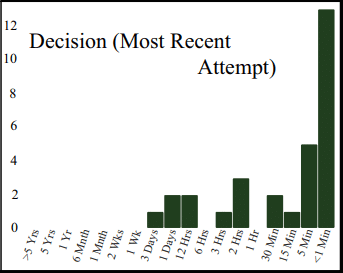
Some studies show that one’s suicidal thoughts can change in intensity and conviction within a few hours.[35] A person may not feel suicidal now but may suddenly feel suicidal less than 4 hours later.
The first thing clinicians look for when a person is deciding on suicide is whether or not they have access to weapons they can use to harm themselves. This is because the window for choosing to take one’s life is so tiny. If a person has a gun at home, then it is easier for them to complete suicide. Making sure that any methods of harm are inaccessible keeps the person safer.[36]
Dr. K assesses his patients’ risk of suicidality by using a scale of risk. It provides a scale to determine how badly the suicidality is at the moment. As a disclaimer, this should, in no way, form the basis of whether one should see a clinician or not.[37]
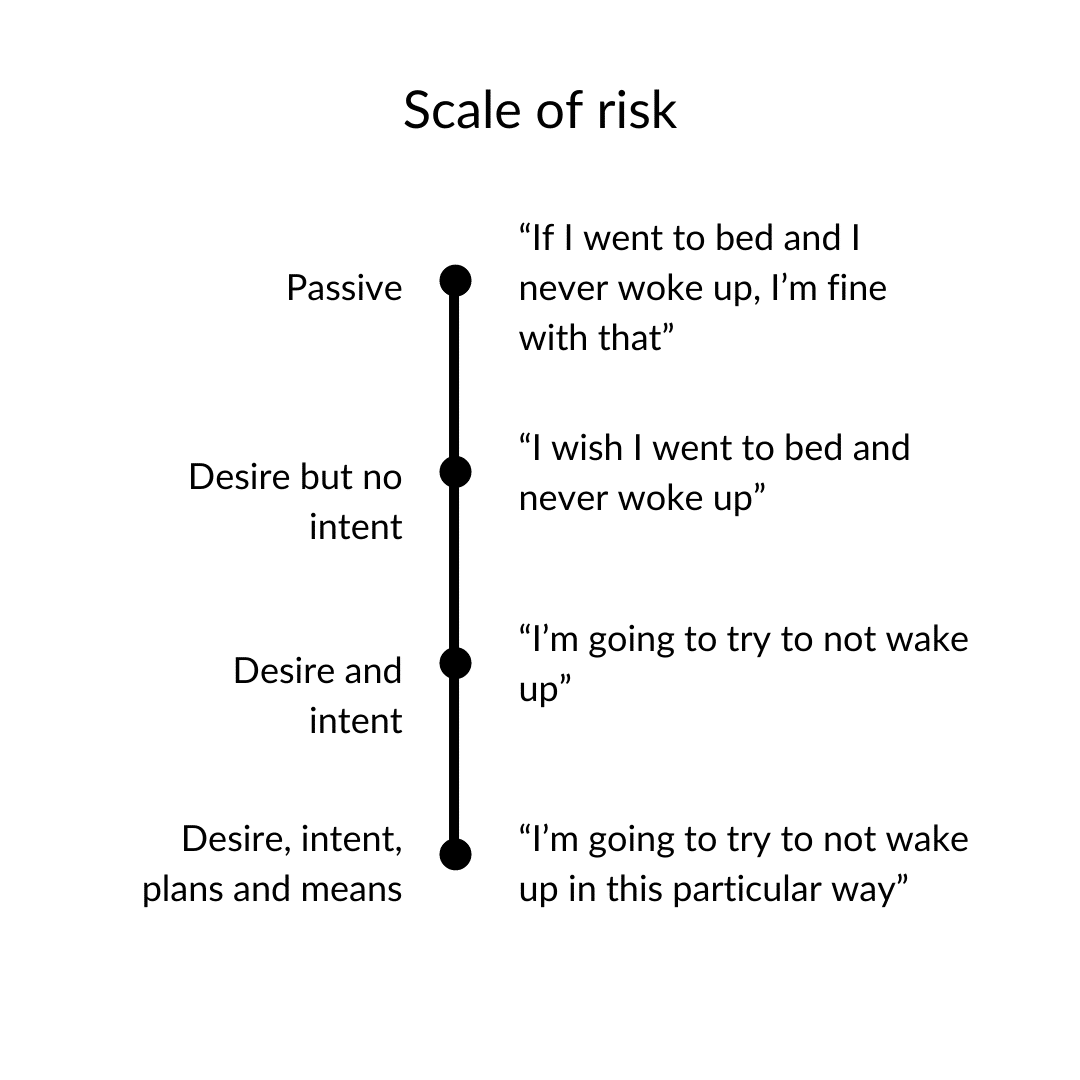
If one finds themselves on any part of the axis above, Dr. K strongly recommends seeking professional help. Even if one doesn’t think they fall anywhere on the scale, they can still go and get evaluated. Know that the mind may sometimes make you believe in things that aren’t true. Like, for example, thinking that your situation is irreparable and nobody else can help you.[38]
Consider situations when you encounter a problem. You will usually seek the appropriate expert in that field. For example, you get a flat tire, you approach a mechanic for help. If you have suicidal thoughts, you seek a psychiatrist who knows how to properly help people with suicidal ideation.[39]
Your life shouldn’t be dictated by your emotions and your thoughts.[40] You may want to listen to them sometimes but not wholly, especially when those thoughts and emotions harm you. Don’t let your mind and emotions control the way you live. Fortunately, there is a big chance helping those at risk through the help of trained and licensed professionals.[41]

If you think you or anyone you know are experiencing any suicidal thoughts or behaviors, please seek help immediately. It is not normal to consider suicide as a solution to stressful situations.[42]
Even if you don’t have any professional training, know that there are some things that you can do to help someone in need.[43]
1. Be a friend to them
You may have some fears that you are not adequately equipped to handle suicide. You are absolutely right, and that’s okay. Here’s why. First and foremost, understand that you are their friend. You are not their psychiatrist, and being a friend is the best thing you can do.
It would mean a lot to them if you reached out and supported them. Some studies show that asking someone about their suicidal thoughts does not lead a person to suicide. It may even help the person think twice about what they are doing.[44] [45] [46]
2. Show them you care
As a friend, you can show them that you are listening and you are there to support them. You can acknowledge what they are going through to show them that you understand. Let them know that you care about them and are concerned about their well-being.[47]
For example, some patients of Dr. K share their traumatic experiences with him. However, because it happened in the past, Dr. K often feels helpless to change the past. He admits to them, “I can’t take this away from you, but I wish I could. I’d like to try to help you in some way. What can we do?” [48]
In doing this, he is sharing in their hopelessness and powerlessness. It’s worth so much to a person knowing that you understand their pain and want to help carry their burden with them.[49]
3. Help them find a professional
After meeting them halfway, you can help them in a practical manner. Offer to make phone calls so that they can get treatment.[50] They may discourage you from finding help due to their hopelessness but let them know that you have a plan to help them until they get in touch with someone.[51]

www.mentalhealthzen.com
These are the things that you can do to help someone dealing with suicide. Remember, you are not their therapist nor a professional; you cannot cure them yourself. However, you are someone who cares deeply for their well-being. As their friend, you are in an extremely valuable position to encourage them to seek help and get treatment.
Suicidal thoughts and behavior may be caused by reasons other than mental illness and psychopathology. Even though many diseases like heart disease and cancer are declining, we are losing the battle against suicide. As a public health concern, each person can play a role in helping those in need.
There is hope for people who are distressed and view suicide as the only option out. The good news is that they can be helped and prevented.[52] Whether the initial help comes from a family member or a friend, as long as they are redirected to properly skilled and trained professionals, it will take them one step closer to getting better.
Again, if you or anyone you know is struggling with suicidal thoughts or behavior, please reach out immediately to a suicide hotline in your area. This website lists down several hotlines you can call based on your location: http://www.suicide.org/international-suicide-hotlines.html